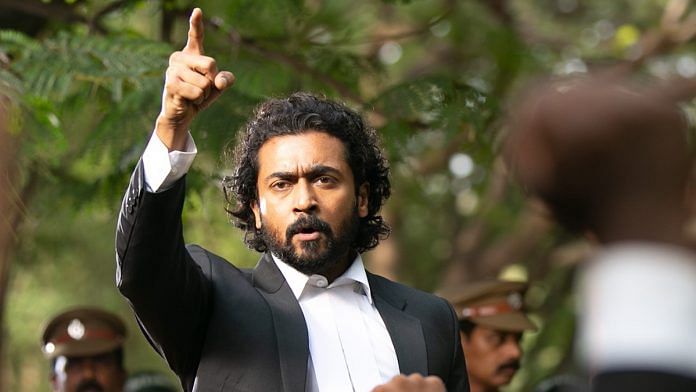Jai Bhim is not just a film but a ‘reality show’ about caste. The very first scene draws you into caste injustices – of then and now. Prisoners are divided into two: ‘dominant’ castes, who are set free, and the ‘oppressed’ castes, who are easily implicated in false cases. Right from the beginning, we learn about the deeply embedded bias within institutions, and how it destroys the possibility of justice. The dominant castes are traditionally affluent and with that historic advantage, can oppress and exploit the oppressed castes.
Also Read: Bollywood has miles to go before it can produce Kaala, Asuran, Karnan or even a Jai Bhim
Lives of Schedule Tribes
As a student, lawyer, and member of the National Human Rights Commission (NHRC), my interactions with people from Scheduled Tribes and Scheduled Castes have been very limited. The ones I met all happened to be educated, held well-established jobs, and were moving forward in life. It was easy to think they were just like me: In values, in opinion, in life-experience and circumstance. Perhaps I thought they had little to offer outside the ordinary and surely we were all equal in opportunity.
When I was a student of law, I tried to find out what a Scheduled Tribe was and what necessitated perseverance of their lifestyle and habitats but I could neither find an answer in the Constitutional provisions nor in the legislative provisions. I am not alone. Most people have no idea about tribal lives and rarely do tribal lives become part of the mainstream discourse (except when SCs and STs are blamed for reservations in jobs). Jai Bhim is a real-life interaction with the tribal life, culture, their closeness to nature, unparalleled skills in handicrafts, nurturing habitats, and knowledge of healing poisons that make them extraordinary people who contribute on so many fronts.
Also Read: Article 15 film wants you to believe caste system came from outer space
Caste-based torture
The film underlines the power equation between the poor and the privileged. Money and class play their part. The lawyers know the game, and the bureaucrats do too. A pregnant woman is beaten inhumanely, a suspect is tortured until compelled to confess to the theft he had nothing to do with, the families are easy hostages, and finally, even the victim disappears. There are no consequences for anyone. How familiar are these incidents? The audience knows they will happen again and again because these are ‘no count’ people. The poor tribals were falsely implicated, that too to save the real culprit. Despite this, from top to bottom — the senior police officials, the government lawyers, and bureaucrats — all dance to the tune of the perpetrator, just because he has a lot of money and promises them a fortune.
The moral to be derived from the film is: The atrocities, money power, and institutional biases can be challenged by fearlessness, knowledge, and commitment to the cause. In the film, the lawyer is a crusader who used the instrument of law for the empowerment of the poor and the prevalence of constitutional values. When the case of a tribal who went missing from police custody came to the lawyer, all the evidence and witnesses were against the tribals. In the high court, the government succeeded in establishing that the tribals had escaped. The lawyer, with his acumen and knowledge, and by visiting different spots of crime, brought before the court the real facts and demolished the fabricated story of the government.
The judiciary also played a pivotal role. The judges accommodated the lawyer at every stage. A sensitive judiciary saves the audience from succumbing to a sense of absolute hopelessness when it helps the lawyers uncover manipulations of the powerful. It hammers home the lesson of the need for the judiciary to be fearless and free from any bias except loyalty to equality and equity before the law.
Also Read: 6 things an anti-caste woke must be mindful of in Ayushmann Khurrana’s new film Article 15
Protection of human rights
On the occasion of Human Rights day, having worked in this area for almost five years, I am of the view that Jai Bhim should be made a part of school syllabus so that students can become the protectors of human rights. The film should also be shown in police training cells to educate officers about the weaknesses in the manipulated investigations and the consequences of them physically and mentally torturing the prisoners. The film can also be a good lesson for law students who are interested in criminal trials to learn the art of cross-examination and how it can unearth the truth.
We, each institution of the State and each individual citizen, must do something about protecting human rights. We must be proactive in teaching Constitutional rights to the public, but most of all to those who wield state power. We must ensure, like the Supreme Court mandate of putting CCTV cameras in places of incarceration, that police are assisted in detecting crime through adequate training and technology. These are solutions well within our ability to achieve.
It is not enough to cry out against human rights violations. Violators may continue to violate the human rights of the weak and the vulnerable until there are knowledgeable and fearless lawyers, human rights defenders, and a non-partisan, sensitive judiciary. Most importantly, a strong law against custodial torture, as recommended by the 152nd Law Commission of India Report, is the need of the hour.
Jyotika Kalra is a Member of the National Human Rights Commission. Views are personal.






